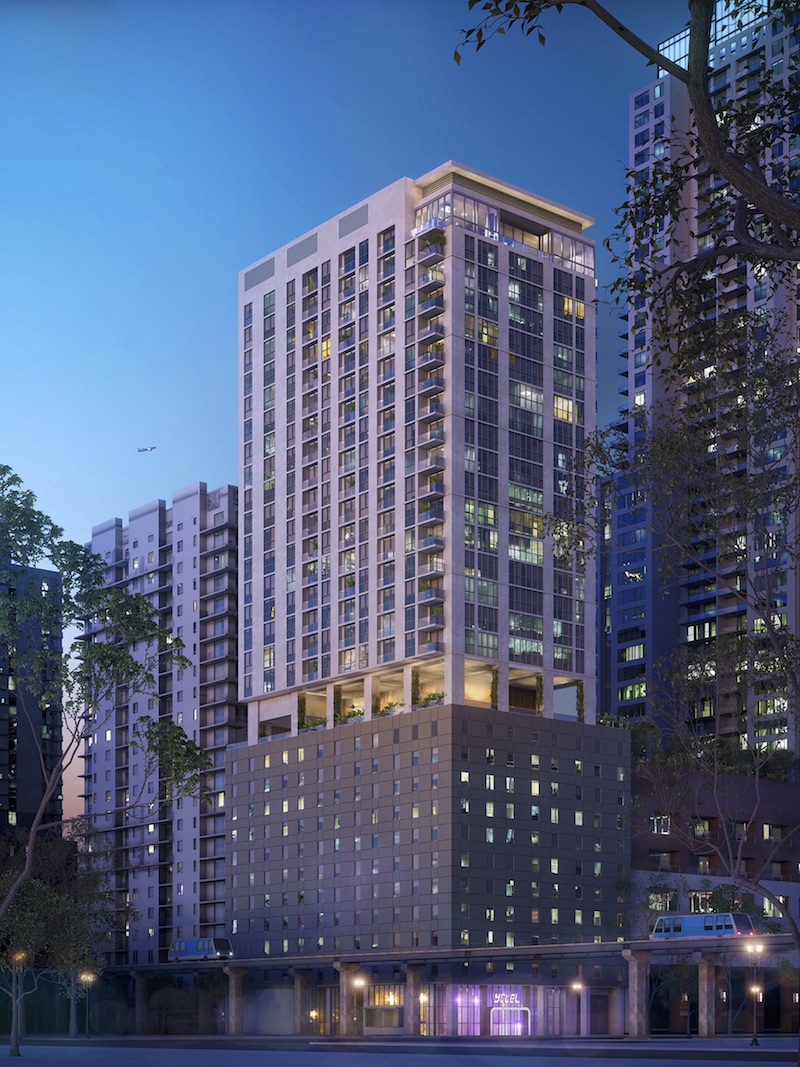YotelPAD Miami, a 31-story hotel/condo project, is currently under construction in Miami’s downtown urban core at 227 NE 2nd Street. Stantec is providing all-inclusive architecture, interior design, and engineering services for the project.
The 327,356-sf tower will feature 222 Yotel-branded “cabins” (hotel rooms) and 231 “PADs” (condominiums). Building amenities will include a Skytop Lounge, a pool deck with a restaurant and bar, a fitness center, co-working space, and a pet spa.
An amenity deck on the 12th floor will separate the building into two distinct elements. The bottom portion of the building (floors 2-12) is the hotel and features a simple geometric design. The condominiums will be located above the amenity pad (floors 15-30) and feature floor-to-ceiling windows and balconies.
See Also: The year-end U.S. hotel construction pipeline continues steady growth trend
The ground level will include separate lobbies for guests and residences, a restaurant, a lounge, an organic matcha bar, and co-working space. Also included for residents are smart lockers for package deliveries, bike storage, and individual storage. Condo units will range from studios to one- and two-bedrooms and range in size from 417 sf to 708 sf.
Aria Development Group and AQARAT are the project’s developers. YotelPAD Miami is slated for completion in early 2021.
Related Stories
| Dec 10, 2013
Modular Pedia-Pod: Sustainability in healthcare construction [slideshow]
Greenbuild 2013 in Philadelphia was the site of a unique display—Pedia-Pod, a modular pediatric treatment room designed and built by NRB, in collaboration with the editors of Building Design+Construction, SGC Horizon LLC, and their team of medical design consultants.
| Dec 3, 2013
Creating a healthcare capital project plan: The truth behind the numbers
When setting up a capital project plan, it's one thing to have the data, but quite another to have the knowledge of the process.
| Nov 27, 2013
Pediatric hospitals improve care with flexible, age-sensitive design
Pediatric hospitals face many of the same concerns as their adult counterparts. Inpatient bed demand is declining, outpatient visits are soaring, and there is a higher level of focus on prevention and reduced readmissions.
| Nov 27, 2013
Exclusive survey: Revenues increased at nearly half of AEC firms in 2013
Forty-six percent of the respondents to an exclusive BD+C survey of AEC professionals reported that revenues had increased this year compared to 2012, with another 24.2% saying cash flow had stayed the same.
| Nov 27, 2013
Wonder walls: 13 choices for the building envelope
BD+C editors present a roundup of the latest technologies and applications in exterior wall systems, from a tapered metal wall installation in Oklahoma to a textured precast concrete solution in North Carolina.
| Nov 26, 2013
Construction costs rise for 22nd straight month in November
Construction costs in North America rose for the 22nd consecutive month in November as labor costs continued to increase, amid growing industry concern over the tight availability of skilled workers.
| Nov 25, 2013
Building Teams need to help owners avoid 'operational stray'
"Operational stray" occurs when a building’s MEP systems don’t work the way they should. Even the most well-designed and constructed building can stray from perfection—and that can cost the owner a ton in unnecessary utility costs. But help is on the way.
| Nov 19, 2013
Pediatric design in an adult hospital setting
Freestanding pediatric facilities have operational and physical characteristics that differ from those of adult facilities.
| Nov 19, 2013
Top 10 green building products for 2014
Assa Abloy's power-over-ethernet access-control locks and Schüco's retrofit façade system are among the products to make BuildingGreen Inc.'s annual Top-10 Green Building Products list.
| Nov 18, 2013
6 checkpoints when designing a pediatric healthcare unit
As more time and money is devoted to neonatal and pediatric research, evidence-based design is playing an increasingly crucial role in the development of healthcare facilities for children. Here are six important factors AEC firms should consider when designing pediatric healthcare facilities.

















